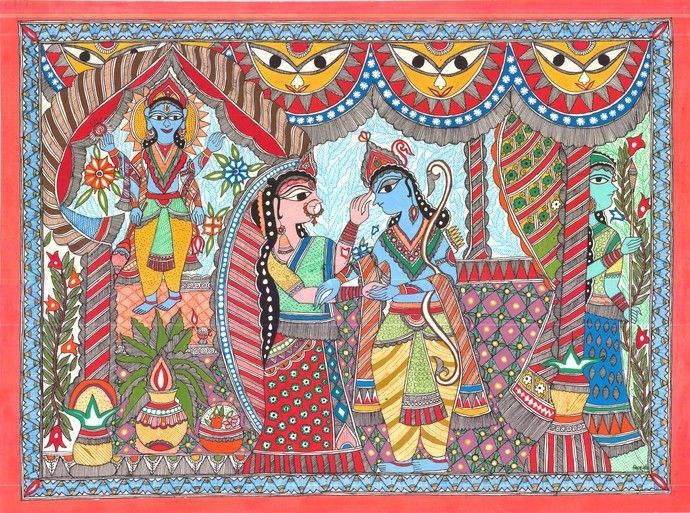Madhubani Art: A Vibrant Indian Folk Tradition

Madhubani Art—also known as Mithila painting—is one of India’s most treasured folk art forms. Originating in the Mithila region of Bihar, this vibrant art is known for its striking patterns, intricate linework, and deep cultural symbolism. For generations, Madhubani art has served as a way to celebrate life, nature, mythology, and community traditions.
Let’s explore the fascinating journey of this traditional Indian art form, its history, unique techniques, and how it continues to flourish in today’s global art scene.
The Origins of Madhubani Art
The roots of Madhubani painting stretch back to ancient India, believed to have originated during the time of the Ramayana. Legend has it that King Janaka commissioned paintings to celebrate the wedding of his daughter, Sita, to Lord Rama.
Originally, these artworks were painted by women directly on the walls of mud huts using natural dyes and handmade brushes—as part of rituals for weddings, festivals, and religious ceremonies. Over time, Madhubani art transitioned from wall paintings to paper, cloth, and canvas, gaining recognition in India and abroad.
Styles and Techniques of Madhubani Painting
What makes Madhubani so unique is its diversity in styles and techniques, each rich in cultural expression:
The Five Main Styles:
Bharni – Bold and colorful, often depicting Hindu deities.
Katchni – Defined by fine lines and delicate patterns of flora and fauna.
Tantrik – Features spiritual and religious symbolism, including chakras and yantras.
Godna – Inspired by tribal tattoo designs, with a minimalist, monochromatic appeal.
Kohbar – Traditionally painted during weddings, representing love, fertility, and prosperity.
Artists use natural pigments derived from plants, charcoal, flowers, and turmeric, applying them with tools made from twigs, bamboo, or even fingers.
Themes and Symbolism
Madhubani art thrives on storytelling through symbols, nature, and mythology. Common motifs include:
Deities: Krishna, Lakshmi, Shiva, and Durga.
Flora & fauna: Peacocks, fish, lotus flowers, elephants.
Nature elements: The Sun, the Tree of Life, and the Moon—symbols of growth, prosperity, and divine power.
Each painting often carries spiritual or social messages, blending folk wisdom with visual poetry.
Revival and Global Recognition
Though Madhubani faced decline in the early 1900s, it experienced a revival in the 1960s, thanks to efforts by Indian cultural bodies and art historians. Women from local villages were encouraged to translate wall paintings onto paper and canvas, leading to widespread exposure.
Today, Madhubani art is internationally admired—seen in art galleries, fashion, home décor, and even on handmade crafts and textiles.
Modern artists use this traditional form to comment on social themes such as women’s rights, environmental conservation, and education, making it relevant in contemporary times.
Conclusion: Preserving a Timeless Heritage
Madhubani art is more than an art form—it's a cultural narrative, reflecting the beliefs, customs, and creativity of the Mithila region. Whether displayed in a rural home or a global art exhibit, it speaks a universal language of beauty, identity, and tradition.
By understanding and supporting Madhubani artists, we help preserve a vibrant piece of India’s folk art heritage, while also celebrating the artistic voices that continue to evolve within this form.
Looking to learn more? Explore authentic collections and support Madhubani artists via organizations like Handmade India and CraftsCouncil.org.
